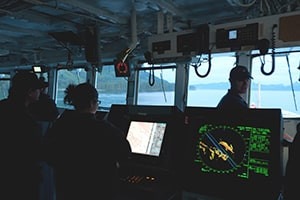On board ships, saltwater can be a menace when it comes to electronics. As a result, marine electronics has become a niche market. This course on circuits and components relates to the branch of physics concerned with the design of electronic circuits alongside the application of different components to marine electronics. The relationship between the science of physics and marine electronics technology has facilitated improved designs for ships and vessels. Marine technology facilitated by electronic components includes movement detection instruments like Chartplotter, compass, sonar (or fishfinder) and GPS. These developments all have electric circuit connections and components whose workings, principles and applications are outlined in this course. We illustrate different circuit conditions that give rise to limitations in applying multiple electronic components and ways to mitigate these limitations. We demonstrate the complex electronic components for you to understand potential dividers and voltage dividers easily. This course also explains the circuit concepts necessary for marine electronics, including the impact of resistances arranged in both series and parallel connections.
The course then gives you a basic understanding of electrical laws and aspects of electronic circuit elements, including capacitors and inductors. Semiconductors, thyristors (SCR), Zener diodes, rectifiers and filters are also discussed. Important lessons on aspects of electrostatic-sensitive components like electrostatic discharge (ESD) and the identification of cables and their usage are provided to enhance your experience. This course will help you identify different electronic components and assist you to distinguish each one based on their workings and uses. The different types of series and parallel circuits are also well explained.
We aim to equip you with an opportunity to study electronics consisting of the basic laws of electricity governing resistance, (for example: Kirchoff’s Laws), all of which are applied by mariners and people engaged in maritime. We will take you through an analogy of materials, resistance and resistivity by studying the fundamental principles of how resistances work. Investigate different electric circuits, observing how various factors affect them. Due to the increase in importing and exporting, the need for transport technologies has increased, and marine electronics has become indispensable. Enrol in this course today! Improve your understanding of circuits and components in marine electronics, their workings and applications in relevant marine systems and make yourself invaluable.
What You Will Learn In This Free Course
View All Learning Outcomes View Less All Alison courses are free to enrol, study, and complete. To successfully complete this Certificate course and become an Alison Graduate, you need to achieve 80% or higher in each course assessment.
Once you have completed this Certificate course, you have the option to acquire an official Certificate, which is a great way to share your achievement with the world.
Your Alison certificate is:
- Ideal for sharing with potential employers.
- Great for your CV, professional social media profiles, and job applications.
- An indication of your commitment to continuously learn, upskill, and achieve high results.
- An incentive for you to continue empowering yourself through lifelong learning.
Alison offers 2 types of Certificate for completed Certificate courses:
- Digital Certificate: a downloadable Certificate in PDF format immediately available to you when you complete your purchase.
- Physical Certificate: a physical version of your officially branded and security-marked Certificate
All Certificate are available to purchase through the Alison Shop. For more information on purchasing Alison Certificate, please visit our FAQs. If you decide not to purchase your Alison Certificate, you can still demonstrate your achievement by sharing your Learner Record or Learner Achievement Verification, both of which are accessible from your Account Settings.











 Avg. Hours
Avg. Hours  Contains Video
Contains Video  CPD Accredited
CPD Accredited 
 Total XP:
Total XP: 
 Knowledge & Skills You Will Learn
Knowledge & Skills You Will Learn 







